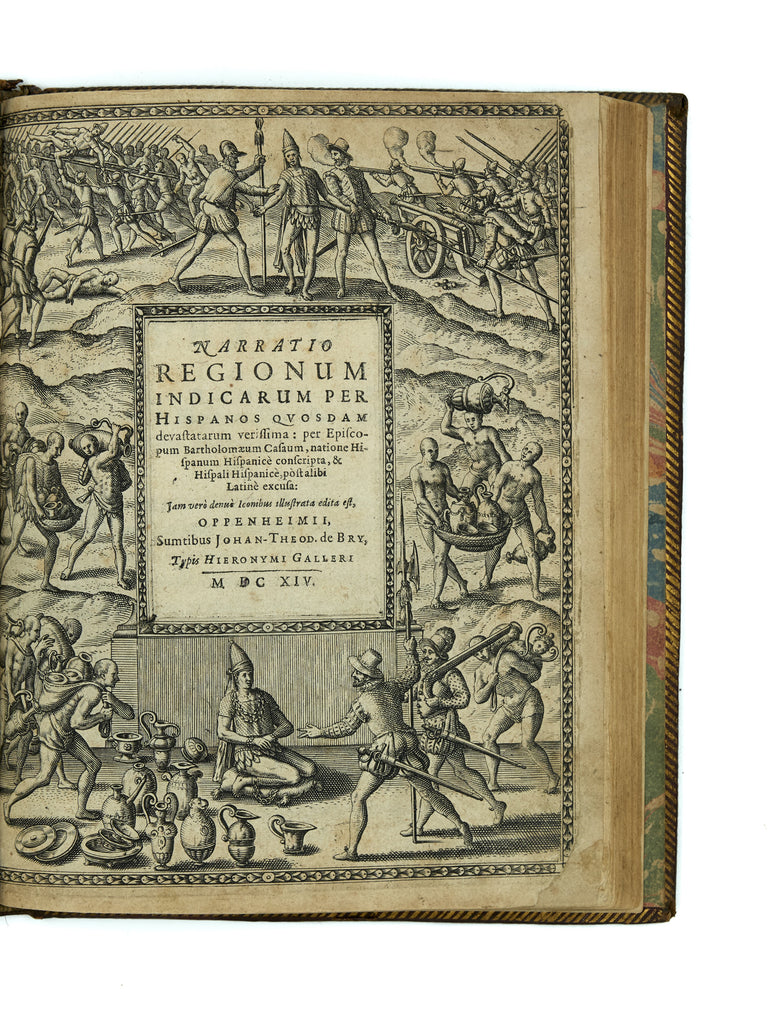Narratio regionum Indicarum per Hispanos quosdam devastatarum verissima
CASAS, Bartholome de las








Oppenheim: Hieronymus Galler for Johann-Theodor de Bry. 1614.
Second edition in Latin. 4to. 190x150mm. pp.138. Title within engraved pictorial border. Seventeen engravings in the text by Theodor de Bry after Jodocus a Winghe (Joos van Winghe) engraved head and tail pieces. Beautifully bound in late seventeenth- or early eighteenth century full brick-red morocco, gilt double fillet border, spine decorated with flower motifs and lettered in gilt "Caseus:Crud:Hisp", marbled endpapers. Front pastedown has armorial bookplate of Edmund Montagu Boyle and the words "The Legacy of". This bookplate is partially pasted over that of Robert Frederick Boyle. Corners rubbed and a little bumped, wear and a small tear to head of spine. Front pastedown has a small hole (10x3mm) and fore-edge of the title page has been repaired. First page of dedication has the inscription, E.J.P [? illegible]. Slight browning and the occasional spotting but otherwise a very nice copy in an attractive binding with the splendid de Bry engravings in especially good condition.
Bartolomé de las Casas's (1484-1566) Brevísima relación de la destrucción de las Indias was written in 1542 and published in Seville in 1552. It describes the cruelty of the Spanish colonisers of the Americas. Las Casas had arrived in Hispaniola in 1502 where he acquired land and slaves. After witnessing horrendous brutality, he gave up his slaves and turned his mind and pen to opposing the Spanish colonial slave system known as encomienda. A failed attempt at establishing a more humane form of colonial rule led to his becoming a Dominican friar (the Dominicans had preached vehement sermons against slavery and the mistreatment of the indigenous tribes and had withheld the sacrament of confession from Spanish slave owners). Remaining in the Americas, he carried out peaceful missionary work, continued to work for the abolition of encomienda and became the Bishop of Chiapas in Mexico. Forced to resign the bishopric in the face of continual disputes with Spanish landowners, las Casas returned to Spain where he advised the Crown on its rule of the Americas. He died in 1566 in his cell at the Collegio de San Gregorio in Valladolid.
Las Casas' motivation in writing this book was, in large part, theological: he feared that Spain would suffer divine punishment for its colonial savagery. The book quickly became a central plank of the "Black Legend" in which the Spanish empire was viewed as the embodiment of venality. Unsurprisingly, it became popular in newly Protestant countries being translated into Dutch, English and German in the sixteenth century. The first Latin edition appeared in 1598 with De Bry's lively and somewhat gory engravings helping to feed anti-Spanish sentiment.
